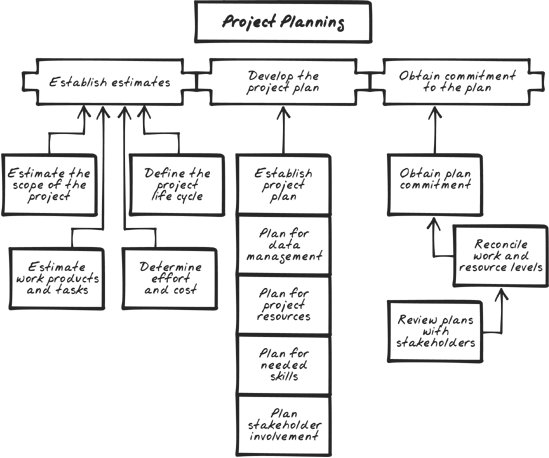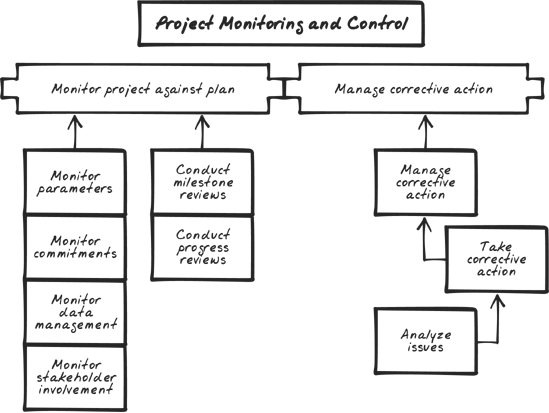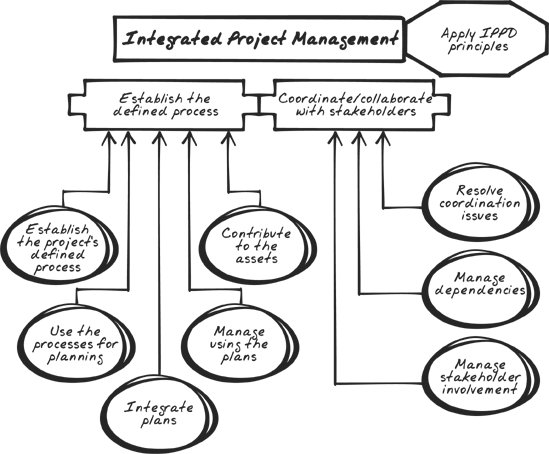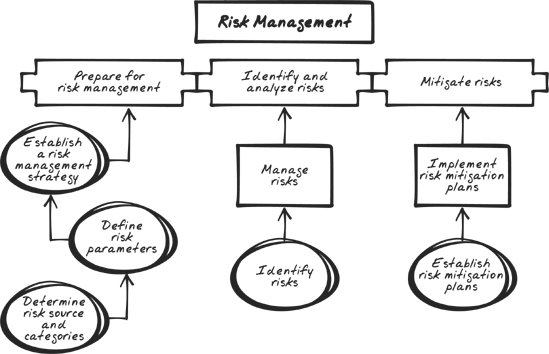Section 6.7. Project Management Process Areas
6.7. Project Management Process AreasThe following sections detail the Process Areas specific to project management. 6.7.1. Project PlanningIn my opinion, the Project Planning Process Area is the single most important PA in the entire CMMI model. Others might dispute that point (and validly), but what's generally accepted is that a reliable quality result can only come from up-front planning: the more, the better. That's why CMMI places such a strong emphasis on planning (just as ISO 9001 and Six Sigma do). The structure of the Project Planning PA helps an organization resist the temptation to hurry up and go. Today we have ample data on what happens when pressure to begin pushes a project into premature action. Issues with resource allocation, budgeting, scheduling, scope, and functionality crop up early and plague a project across its life cycle. Planning is a way to reduce these kinds of problems (and the risks they bring). A well-designed planning program provides two key benefits to any project effort: it provides a road map for thinking a project through prior to making commitments, and it delivers a medium for agreement between parties as to how the project will be managed. 6.7.1.1. Three specific goalsThere are three goals in the Project Planning PA, each designed to strengthen your position in meeting a project's objectives:
6.7.1.2. Core Project Planning actionsDocument a project plan using the best estimates and information at your disposal. Then involve team members and stakeholders in reviewing and approving the plan in order to establish a contract of agreement among parties as to how the project will be managed. Applies to Project Management:
Figure 6-1 illustrates the Project Planning PA. Figure 6-1. The activities that make up Project Planning center on establishing a viable and practical plan for the project. This includes first establishing estimates of the scope and size of the project; defining management activities for resources, schedules, budgets, stakeholders, and data; and then working with the organization to review the plan and ultimately obtain commitment to it. 6.7.2. Project Monitoring and ControlThe Project Monitoring and Control Process Area is a logical extension of Project Planning. In planning, you document the resources, activities, and constraints anticipated for a project. You then use the plan as the chief reference tool for monitoring the project's progress. Effective monitoring includes the use of regular status meetings, stakeholder communications, product inspections, and audits. Control is the proactive counterpoint to monitoring. When the actuals on a projectthe details of what is actually transpiringbegin to vary significantly from what was planned, you should take corrective action to bring the plan back into sync with the project, either by reversioning the plan or adjusting the scope of the project. 6.7.2.1. Two specific goalsCMMI assigns two goals to Project Monitoring and Control:
6.7.2.2. Core Project Monitoring and Control actionsProject management tracks the actual progress of the project against documented projections in the plan. When significant variance occurs between what was planned for and what is actually happening, the PM takes corrective action to realign the plan with project activity. Applies to Project Management:
Figure 6-2 illustrates the Project Monitoring and Oversight PA. Figure 6-2. Project Monitoring and Control is the natural extension of Project Planning. Here, actual project activities are monitored against what was anticipated in the plan. Monitored items include the budget, schedule, risks, stakeholder involvement, and milestones and deliverables. When corrective action needs to be taken, the actions are tracked to closure. 6.7.3. Integrated Project ManagementIntegrated Project Management supports the coordination of disparate work groups and elements within a project. It combines the facets of Project Planning and Project Monitoring and Control with activities to focus these elements for enhanced project control. This Process Area includes practices that help project management identify and select the right processes for a particular project from the organization's process repository (see "Organizational Process Definition," later in this chapter). Also included are activities to tailor the processes to the needs of the project, managing the project objectives with the active involvement of designated stakeholders, creating and communicating a shared project vision with the stakeholders, and creating integrated teams based on the specific technical and production needs of the project. 6.7.3.1. Three specific goalsCMMI defines three goals for Integrated Project Management:
The third goal is for use when you are using CMMI for Integrated Product and Process Development:
6.7.3.2. Core Integrated Project Management actionsProject management coordinates the use of organizational process sets, integrates plans and teams, and ensures stakeholder involvement across the life of the project. Applies to Project Management:
Figure 6-3 illustrates the Integrated Project Management PA. Figure 6-3. Integrated Project Management is the natural extension of Project Monitoring and Control. Here, institutionalized processes are defined for the project, stakeholder involvement and coordination is promoted, and IPPD principles, where applicable, are applied. 6.7.4. Quantitative Project ManagementQuantitative Project Management is an advanced technique used by mature organizations to plan for and gauge project success. This Process Area extends the reach of Project Monitoring and Control and Integrated Project Management. The basic modus operandi of PM&C is to track actual values against planned values. The values here are usually snapshots of substantial project components, such as the schedule, the budget, the number of resources, the risks, and so on. When one or more of these values begins to vary significantly from what was planned, the project manager takes corrective action. The concept of "significant variance," however, is not really tangibly defined with PM&C; that call is left to the experience and intuition of the project manager. The corrective action is likewise a discretionary move. Quantitative Project Management adds a layer of engineering granularity to this process. To begin with, under QPM, progress is mapped numerically. For example, a measure that shows the design phase as being three days ahead of schedule might be calculated as being 109 percent on target. That percentage is more meaningful (for analysis and reporting) than, say, "+3 days." With such measures, project management also monitors the efficiencies of subprocesses within the project. Quantitative measures are taken to assess the performance of these processes against anticipated or expected goals. As another example, a requirements review process that was executed with 4 missed steps out of 20 might receive a performance score of 80. That hard score can then be compared against other projects or a preset scorecard to determine the success of the process for that project. Effective Quantitative Project Management relies on a backlog of accumulated project performance data, thoughtful and analytical project planning, and firm control over the execution of a project. 6.7.4.1. Two specific goalsCMMI defines two goals for this Process Area:
6.7.4.2. Core Quantitative Project Management actionsIn addition to the basic monitoring of schedule, funding, and resource attributes, project management performs oversight on the project by regularly comparing quantitative measures of quality, performance, and process efficiencies to preset goals around process performance. Applies to Project Management:
Figure 6-4 illustrates the Quantitative Project Management PA. Figure 6-4. Quantitative Project Management is a high-maturity, high-capability Process Area. Here the team uses quantitative measures and statistical techniques to monitor the performance of selected project processes to ensure that their performance will meet targeted expectations. Of special interest are subprocesses. These are continually measured across the project to anticipate current performance and predict future performance. 6.7.5. Risk ManagementThe Risk Management Process Area extends the capabilities of Project Planning and Project Monitoring and Control. Basic project planning calls for the identification of potential risks. And basic project monitoring calls for tracking risks that could threaten a project. Risk Management introduces an organized and planned approach for continuously dealing with risks, one that uses a proactive organizational methodology. This methodology takes what could be thought of as free-range risks and corrals them into categories. The organization then develops strategies to address the inherent traits of the different risk categories. These strategies are then applied at the project level, where potential risks are explicitly identified and their impacts assessed as early as possible. The mitigation steps that emerge from this activity are then encompassed in a Risk Management Plan that becomes part of the overall project plan. The Risk Management Process Area represents a step to quantify (to a degree) something that we typically regard as a hazy intangible or, at best, as a distinct but removed potential. It helps an organization forge a set of tools useful in circumventing the pitfalls that come from avoiding the issue of risks or from dealing with them in a reactive, half-considered manner. 6.7.5.1. Three specific goalsCMMI defines three goals for Risk Management:
The risk planrisks identified and prioritized, with mitigation actionscan then become a component of the overall project plan. 6.7.5.2. Core Risk Management actionsThe organization defines the types of risks its projects typically encounter, identifies specific risks for each project, and develops a management plan for each project, which details how risks will be mitigated should they materialize. Applies to Project Management:
Figure 6-5 illustrates the Risk Management PA. Figure 6-5. Risk Management is designed to help project teams plan for risk and then effectively mitigate the effects of risks on project plans and objectives. This involves a preparatory step: defining currently known risk categories and acceptable plans to address them. As a project unfolds and risks emerge, risk plans are developed, implemented, and tracked for effectiveness. 6.7.6. Supplier Agreement ManagementThe Supplier Agreement Management Process Area addresses the need to acquire outside products or services that are required to fulfill the expectations or scope of a development project. As an example, a project intended to create an online e-store might seek to acquire a piece of finished code that processes Visa and MasterCard transactions. To ensure that this acquisition process is structured with adequate quality controls, the organization should establish a program that manages interplay and agreements between suppliers and the organization. The Supplier Agreement Management Process Area provides the framework for such a program. This Process Area helps organizations establish standards for determining the type of acquisition required, criteria for selecting qualified suppliers, considerations for executing and managing supplier agreements, protocols for product inspection, and guidelines for transitioning acquired products into the organization. 6.7.6.1. Two specific goalsCMMI defines two goals for Supplier Agreement:
6.7.6.2. Core Supplier Agreement actionsThe organization defines the methods for acceptable selection and use of third-party products and services, detailing supplier selection criteria, product suitability requirements, and boilerplate supplier agreements. Also promoted is the monitoring of selected supplier processes and iterative work products. Applies to Project Management:
Figure 6-6 illustrates the Supplier Agreement Management PA. Figure 6-6. Supplier Agreement Management is designed to help organizations deal with external suppliers effectively, ensuring the integrity of acquired deliverables. This includes understanding types of acquisitions made, providing for a means of pre-inspection of available products, selecting qualified suppliers, and formalizing criteria for deliverable acceptance and transition.
|
EAN: 2147483647
Pages: 116